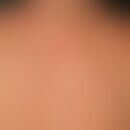Synonym(s)
DefinitionThis section has been translated automatically.
Pathologically increased facial, sexual and body hair (= androgen-dependent regions = male hair pattern) in women and children according to the respective hair type. Hirsutism is a partial symptom of virilization. Hirsutism has to be distinguished from hypertrichosis, which is a circumscribed or generalized increase of body hair without preference of androgen-dependent regions.
ClassificationThis section has been translated automatically.
Depending on the cause, different forms of hirsutism can be distinguished (according to Trüeb RM 2003):
Endocrine hirsutism/symptomatic hirsutism: Causes can be hyperfunctions, benign or malignant tumors of the adrenal cortex, the pituitary gland as well as virilizing ovarian tumors. Also occurs during pregnancy and after menopause. Specifically in:
- Ovarian hirsutism
- Polycystic ovary syndrome (PCOS).
- Androgen producing ovarian tumors
- Sertoli-Leydig cell tumor (androblastoma, arrhenoblastoma)
- Hilar cell tumor
- Gonadoblastoma
- Luteoma gravidarum
- Adrenal hirsutism
- Congenital adrenocortical hyperplasia (adrenogenital syndrome)
- 21-hydroxylase deficiency
- 3beta-steroid dehydrogenase deficiency
- 11beta-hydroxylase deficiency
- Adrenocortical tumors
- Androgen-producing adrenocortical adenoma
- Androgen-producing adrenocortical carcinoma
- Primary adrenal Cushing's syndrome
- Congenital adrenocortical hyperplasia (adrenogenital syndrome)
- Pituitary hirsutism
- Hypothalamic-pituitary Cushing's syndrome (ACTH cell hyperplasia)
- Cushing's disease (pituitary adenoma)
-
Hyperprolactinemia
- Prolactinoma (Forbes-Albright syndrome)
- Chiari-Frommel syndrome (postpartum)
- Secondary hyperprolactinemia (neuroleptics, hypothyroidism)
- Idiopathic (Argonz-Ahumada-del Castillo syndrome)
- Secondary hyperprolactinemia (neuroleptics, hypothyroidism)
-
Acromegaly
- Acromegaly with insulin resistance
- HAIR-AN syndrome
- Postmenopausal hirsutism
- Obesity (?)
- stress(?)
Non-endocrine hirsutism
- Idiopathic hirsutism: Normal to borderline testosterone or dehydroepiandrosterone sulfate serum levels in about 90% of cases. There is probably increased testosterone sensitivity of the hair follicles.
- Familial
- Ethnic
- Sporadic
- SAHA syndrome (peripheral androgenization)
- Achard-Thiers syndrome
- Morgagni-Morel syndrome
- Congenital adrenogenital syndrome (AGS)
- Cornelia de Lange syndrome
- Drug-induced hirsutism (drug hirsutism)
- In the context of prolonged or high-dose androgen, anabolic steroid, and rarely progestin, ACTH, or glucocorticoid therapy.
- Diazoxide
- Diphenylhydantoin
- Ketoconazole
- D-penicillamine
- Phenytoin
- spironolactone.
- Hirsutism of other genesis: Among others in:
- anorexia nervosa
- Porphyrias
- neurological diseases.
You might also be interested in
Occurrence/EpidemiologyThis section has been translated automatically.
Occurs in about 3-5% (-10%) of all women in industrialized countries. There are large ethnic differences. Hirsutimus is often found in Mediterranean populations, less frequently in northern European East Asian populations.
EtiopathogenesisThis section has been translated automatically.
The occurrence of hirsutism in women is closely related to androgen metabolism. This depends on:
- the glandular production (ovary, adrenal cortex)
- the extraglandular or peripheral enzymatic activity (aromatase, 5alpha-reductase)
- the cellular response to androgenic stimulation (receptor sensitivity).
Dei major androgens, in order of decreasing potency, are:
- Dihydrotestosterone (DHT)
- Testosterone
- Androstenedione
- Dehydroepiabdrosterone (DHEA)
In men, testicular testosterone represents the major circulating androgen. In women, it is ovarian androstenedione, which in turn is reversibly interconventible with testosterone under enzymatic control, allowing target organs to alter acute androgen activity in situ.
LocalizationThis section has been translated automatically.
DiagnosisThis section has been translated automatically.
Anamnesis with recording of genetic factors and intake of pharmaceuticals. Clinical findings (cycle disorders, sterility, virilization symptoms, acne vulgaris, alopecia, libido)
Basic endocrinological diagnostics
- Total testosterone (1st-5th day of cycle)
- DHEA-S (1st - 5th cycle day)
- For amenorrhoea: exclusion from pregnancy
- If pregnancy is ruled out:
Further diagnostics
- androstenedione
- Cortisol
- 17-alpha-OH-progesterone (elevated in adrenogenic syndrome)
- Dexamethasone inhibition test (differentiation of functional from autonomous adrenal cortex processes)
Further diagnostics for mainly specific conditions with hyperandrogenemia
-
Polycystic ovary syndrome (PCOS)
- Vaginal sonographic examination of the ovaries
- Ovarian suppression test (differentiation of an extra-ovarian disorder or an autonomic process
- HBA1c
- Adrenogential syndrome
- ACTH stimulation test
- Androgen producing ovarian tumor
- Vaginal sonographic examination of the ovaries
- Adrenal cortex tumor
- Dexamethasone inhibition test
- Adrenal CT or MRI
TherapyThis section has been translated automatically.
- Treatment of the underlying disease (in cooperation with internists or gynaecologists).
- In case of endocrine (ovarian) non-tumour-related hirsutism, treatment with ovulation inhibitors may be applied (daily oestrogen dose should be 50 μg). It is advisable to use progestins with antiandrogenic effects (e.g. cyproterone acetate).
- Symptomatic therapy for circumscribed forms (e.g. lip and cheek area).
- Therapy methods for epilation or hair growth slowdown:
- Eflornithine HCL 13.9% cream (Vaniqua): inhibition of ornithine decarboxylase in the hair root. Apply thinly 2 times/day. Effect after 4-8 weeks. In combination with laser depilation significantly more effective than laser therapy alone. Significant improvement in 70% of patients. Basically it can be said about the efficiency of Eflornithine HCL that 1/3 of the patients respond very well, 1/3 moderately well and 1/3 not at all. The effect is lost 8 weeks after discontinuation of the therapy.
- Electrocoagulation or diathermy coagulation of the hair roots, multiple treatments necessary.
- Application of waxes (apply hot wax and remove after cooling).
- Application of depilation creams; afterwards remove hair with a spatula.
- Bleaching of hair, application of a 5-20% hydrogen peroxide solution.
- Laser and flash lamp depilation: this is the best way to achieve the best long-term effects. With the Alexandrite laser, a permanent hair reduction of 75% is achieved after 6-8 sessions.
TablesThis section has been translated automatically.
Endocrine drug therapy of hirsutism
Light forms |
Chloromadion acetate in combination with mestranol (e.g. Gestamestrol N) or in combination with ethinylestradiol (e.g. neo-unomine). |
Moderately severe forms |
antiandrogenic therapy with cyproterone acetate (e.g. Androcur). From day 5-15 of the cycle 50-100 mg/day p.o., additionally obligatory contraception with ethiniloestradiol (e.g. ethinylestradiol 25 µg Jenapharm) 40-60 μg/day p.o. on day 5-25 (alternatively e.g. Diane). |
Severe forms |
Anti-androgen therapy as before. Increase the dose of cyproterone acetate to 200 mg/day p.o. |
Hirsutism in women in menopause or after uterine extirpation |
Continuous long-term therapy with cyproterone acetate 50-100 mg/day p.o. Therapy approaches with spironolactone 100 mg/day p.o. (e.g. Aldactone) or cimetidine (e.g. Tagamet 1200 mg/day p.o.) are generally less effective than cyproterone acetate, information about side effects. |
Diseases |
Cause |
Frequency (%) |
|
Ovarian causes |
Insulin Resistance Syndrome |
|
1 |
Androgen-producing tumours |
e.g. endometrial carcinoma |
< 1 |
|
Luteoma (pregnancy virilization) |
|
< 1 |
|
| |||
Adrenal causes |
Adrenogenital syndrome |
21-hydroxylase deficiency |
1 |
other causes such as 11-/17-hydroxylase deficiency |
< 1 |
||
Cushing's tumors |
e.g. pituitary tumours |
< 1 |
|
| |||
Combines ovarian and adrenal causes |
Idiopathic (familial) hirsutism |
|
95 |
Polycystic ovary syndrome (PCOS) |
< 1 |
||
| |||
Exogenous androgens |
|
drugs like anabolic steroids |
< 1 |
LiteratureThis section has been translated automatically.
- Ali I, Dawber R (2004) Hirsutism: diagnosis and management. Hosp Med 65: 293-297
- Bergfeld W et al (1987) Hirsutism. Dermatol Clin 5: 501-507
- Hamzavi I (2007) A randomized bilateral vehicle-controlled study of eflornithine cream combined with laser treatment versus laser treatment alone for facial hirsutism in women. J Am Acad Dermatol 57: 54-59
- Hickman JG et al (2001) Human dermal safety with eflornithine HCL 13.9% cream (Vaniqa), a novel treatment for excessive facial hair. Curr Med Res Opin 15: 235-244
- Ozlu E et al (2018) Comparison of cutaneous manifestations in diabetic and nondiabetic obesepatients
: A prospective, controlled study. North Clinic Istanb 5:114-119. - Schrode K et al (2000) Randomized, double-blind, vehicle-controlled safety and efficacy evaluation of eflornithine 15% cream in the treatment of women with excessive facial hair. 58th annual meeting of the Academy of Dermatology, San Francisco, Poster 291
- Trueb RM (2003) New and established methods in therapy of hair diseases. dermatologist 54: 732-740
Trüeb RM (2003) Haare, Praxis der Trichologie Steinkopff Verlag Darmstadt SS 440-441:
- Wolff H, Kunte C (2002) Alopecia and hirsutism. Grief with beautiful hair. MMW Fortschr Med 144: 37-39
Incoming links (31)
Achard-thiers syndrome; Acromegaly; Androgenization; Antiandrogen-oestrogen combinations; Ataxia teleangiectatica; Bohring Opitz Syndrome; Budesonide; Ciclosporin a; Cushing's syndrome (overview); Cyproterone acetate; ... Show allOutgoing links (27)
Achard-thiers syndrome; Acne (overview); Acromegaly; Alexandrite laser; Alopecia (overview); Anorexia nervosa, skin changes; Congenital adrenal hyperplasia1; Cushing's syndrome (overview); Cyproterone acetate; Dhea; ... Show allDisclaimer
Please ask your physician for a reliable diagnosis. This website is only meant as a reference.











